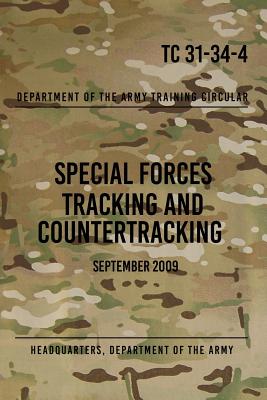TC 31-34-4 Special Forces Tracking and Countertracking: September 2009

TC 31-34-4 Special Forces Tracking and Countertracking: September 2009
Before the industrial age, human beings routinely relied upon tracking skills for tens of thousands of years as a means to run down prey, avoid predators and determine whether other tribes were transiting their land. To see an indigenous tracker at work, one could almost swear that the uncanny skills were based in part on telepathy. Nothing could be further from the truth - trackers rely upon a suite of standard rules and techniques which can be learned by anyone and put to good use in the field. Although it will take years of practise and training for tracking abilities to develop to the extent they become almost unconscious, the basics skills of tracking and countertracking are worth learning for every soldier. It is therefore not surprising that the US Army Special Forces have been steadily reviving the nearly lost arts of tracking and countertracking for the past several years.
From the preface page: "SF Soldiers routinely employ unconventional tactics and techniques while conducting operations unilaterally and with indigenous assistance. The conduct of SF differs from conventional operations in the degree of political risk, operational techniques, independence from friendly support, and dependence on detailed operational intelligence and indigenous assets. The success of SF operations within these parameters depends greatly on the team's ability to read "signs" for defensive purposes and its ability to use that same knowledge to minimize the signs it leaves when transitioning through hostile terrain."
This training circular provides a doctrinal framework for Special Forces personnel involved in tracking and countertracking operations. Tracking, countertracking, and dog-tracker team operations are basic and fundamental to every SF operation whether offensive or defensive in nature. This TC describes and illustrates how to track, how to avoid being tracked, and the theory behind the use of dog-tracker teams. Appendixes A and B provide SF Soldiers with sample tracking logs for their use. This TC provides the basis for common SF tactical application primarily in a rural environment and it briefly discusses urban tracking using dog teams.
Presented in Special Operations Press' distinctive OCP camouflage cover denoting a current publication, this manual is printed in easy-to-read 6 x 9, perfect-bound paperback format. Proudly printed in the USA.
PRP: 131.67 Lei
Acesta este Prețul Recomandat de Producător. Prețul de vânzare al produsului este afișat mai jos.
118.50Lei
118.50Lei
131.67 LeiLivrare in 2-4 saptamani
Descrierea produsului
Before the industrial age, human beings routinely relied upon tracking skills for tens of thousands of years as a means to run down prey, avoid predators and determine whether other tribes were transiting their land. To see an indigenous tracker at work, one could almost swear that the uncanny skills were based in part on telepathy. Nothing could be further from the truth - trackers rely upon a suite of standard rules and techniques which can be learned by anyone and put to good use in the field. Although it will take years of practise and training for tracking abilities to develop to the extent they become almost unconscious, the basics skills of tracking and countertracking are worth learning for every soldier. It is therefore not surprising that the US Army Special Forces have been steadily reviving the nearly lost arts of tracking and countertracking for the past several years.
From the preface page: "SF Soldiers routinely employ unconventional tactics and techniques while conducting operations unilaterally and with indigenous assistance. The conduct of SF differs from conventional operations in the degree of political risk, operational techniques, independence from friendly support, and dependence on detailed operational intelligence and indigenous assets. The success of SF operations within these parameters depends greatly on the team's ability to read "signs" for defensive purposes and its ability to use that same knowledge to minimize the signs it leaves when transitioning through hostile terrain."
This training circular provides a doctrinal framework for Special Forces personnel involved in tracking and countertracking operations. Tracking, countertracking, and dog-tracker team operations are basic and fundamental to every SF operation whether offensive or defensive in nature. This TC describes and illustrates how to track, how to avoid being tracked, and the theory behind the use of dog-tracker teams. Appendixes A and B provide SF Soldiers with sample tracking logs for their use. This TC provides the basis for common SF tactical application primarily in a rural environment and it briefly discusses urban tracking using dog teams.
Presented in Special Operations Press' distinctive OCP camouflage cover denoting a current publication, this manual is printed in easy-to-read 6 x 9, perfect-bound paperback format. Proudly printed in the USA.
Detaliile produsului










